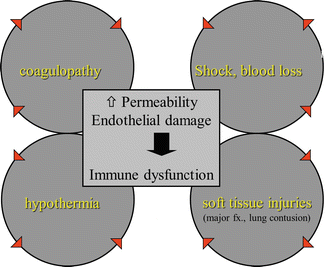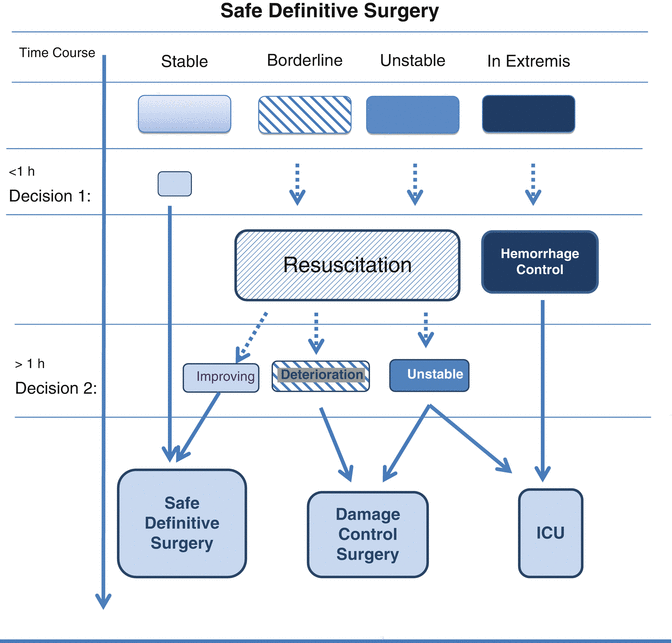Closed fracture G0: No injury or very minor soft tissue injury. The G0 classification covers simple fractures, i.e., fractures caused by indirect injury mechanisms
Closed fracture G1: Inside-out contusions caused by fracture fragments
Closed fracture G2: Deep, contaminated abrasions or local dermal and muscular contusions. Impending compartment syndrome is usually associated with a G2 lesion. These injuries usually are caused by direct forces that shear off soft tissue and are often associated with moderate to severe fracture types
Closed fracture G3: Extensive skin contusions, muscular disruption, decollement, and obvious compartment syndrome combined with any closed fracture are graded as G3. In this subgroup, severe fracture types and comminuted fractures are usually seen
Specific attention has to be dedicated to the presence of compartment syndromes. These should be anticipated when the capillary perfusion pressure is less than intracompartmental pressure. Pain out of proportion in responsive patients is the hallmark indicator. In sedated patients, measurement of intracompartmental pressures is mandatory. Elevated compartment pressures should be treated with emergent fasciotomy.
12.4 Fracture Treatment
12.4.1 Upper Versus Lower Extremity Injuries
In severe open fractures of the upper extremity, certain principles are different from those of the lower extremities. It is widely accepted that surgical management of lower extremities precedes the treatment of upper limb injuries. Moreover, the maintenance of correct length is less important in the treatment of upper extremity fractures. Severe upper extremity injuries, such as open fractures, compartment syndrome, and concomitant vascular injuries require immediate surgical management. In general, splinting or definitive fixation are more frequently performed in the upper extremity because soft tissue coverage is usually easier.
12.4.2 Fracture Care in Serial Extremity Fractures
The sequence of fracture care in patients with serial extremity injuries is important. Simultaneous treatment of extremity injuries can be achieved if the logistic conditions allow the surgeon to do so. The recommendations for the timing of fixation are summarized as follows:
In serial injuries of the upper extremity, immobilization of humeral shaft fractures is an adequate option unless the injuries are open or if neurovascular injuries require surgical intervention. In forearm fractures, early fixation is advised due to limited soft tissue coverage.
In periarticular fractures, early fixation should be performed if the patient’s condition is adequate. If no definitive fixation can be performed and if the patient goes to the OR for other causes, transarticular external fixation (TEF) is preferred over casting. External fixation allows for better stability and assessment of soft tissues. This is of utmost importance due to the risk of compartment syndrome in these injuries.
In serial injuries of the lower extremities, definitive fixation should be achieved whenever possible. In floating knee injuries, retrograde femoral nails and antegrade tibial nails can be placed using the same incision. In unstable patients, closed reduction and transarticular external fixation is performed for temporary fracture stabilization.
In metadiaphyseal and periarticular fractures, the priorities of care are dictated by the degree of soft tissue damage. The orthopedic emergencies that require operative care are as follows:
Compartment syndrome
Vascular injuries
Irreducible hip dislocation
Open fractures
Among the higher priorities are femoral head fractures (Pipkin I-III) and fractures of the talus. Any other periarticular fracture is of lower priority, if no further complication is evident (compartment syndrome, pulse less extremity, or open fracture).
In the care of upper extremity fractures, similar principles are applied. In bilateral fractures, simultaneous treatment should be considered. Both extremities can be draped at the same time. Some parts of the procedure may require operative treatment of only one extremity at the time because of fluoroscopy, or handling issues. If the vital signs of the patient deteriorate during the operation, the second extremity may just be temporarily stabilized using external fixation. The classification system of complex extremity fractures is shown in Table 12.2.
Fracture-associated injury | Points |
|---|---|
Severe soft tissue damage | 2 |
+ hemorrhagic shock | 3 |
ISS 16–25 | 1 |
ISS > 25 | 2 |
Neurovascular injury | 1 |
Articular involvement | 1 |
Type of complex extremity fracture | Points | Fracture care |
|---|---|---|
Low risk | 1–2 | Definitive internal |
Moderate risk | 3–4 | External |
High risk | >4 | Consider amputation |
12.5 Stages in Polytrauma
Initial fracture care of severely injured patients requires anticipation of potential problems and decision making about the timing of interventions using a systematic approach [9]. In general, four different phases of the posttraumatic course are separated:
1.
Acute phase (1–3 h): resuscitation
2.
Primary phase (1–48 h): stabilization
3.
Secondary period (2–10 days): regeneration
4.
Tertiary period (weeks to months after trauma): reconstruction and rehabilitation
12.5.1 Acute Phase (1–3 h After Admission): Resuscitation/Hemorrhage Control
Initially, the focus of treatment lies in the control of acute life-threatening conditions. Complete patient assessment is required to identify all life-threatening conditions. This involves airway control, thoracocentesis, rapid control of external bleeding, and fluid and/or blood replacement therapy. Decompression in head injuries with impending herniation may outweigh all other measures. Prioritization of the orthopedic injuries is crucial as well. The orthopedic fractures that require immediate surgery are listed above. Spinal and pelvic fractures are covered in different chapters.
12.5.2 Primary Phase (1–48 h): Stabilization of Fractures
The primary phase is the usual time where major extremity injuries are managed. These include acute stabilization of major extremity fractures associated with arterial injuries and compartment syndrome. Fractures can be temporally stabilized by external fixation and the compartments released where appropriate. Systemic complications, such as development of systemic inflammatory response syndrome (SIRS) and acute lung injury (ALI), have to be considered if major musculoskeletal injuries are present.
12.5.3 Secondary Period (2–10 Days): Regeneration
During the secondary phase, the general condition of the patient is stabilized and monitored. In most cases, this implies 2–4 days after trauma. Surgical interventions should be limited to those absolutely required (“second look,” debridement) and lengthy procedures should be avoided. Physiological and intensive care scoring systems help monitor the clinical progress.
12.5.4 Tertiary Period (Weeks to Months After Trauma): Reconstruction and Rehabilitation
During the tertiary phase, the patient is able to undergo definitive fracture stabilization. Intensive rehabilitation can help maintain range of motion and improve functional outcomes, social reintegration, and return to work.
12.5.5 Assessment of the Patient
Blunt injuries to extremities and trunk (thorax and abdomen) have been shown to be of immense importance to clinical course of severely injured patients [10]. Patients with multiple blunt traumas have to be assessed for “four pathophysiologic cascades” (hemorrhagic shock, coagulopathy, hypothermia, and soft tissue injuries) in order to avoid life-threatening systemic complications (Fig. 12.1). These cascades have common end point that results in endothelial damage [10].


Fig. 12.1
Four vicious cycles demonstrate the pathophysiological cascades. These are known to be associated with the development of posttraumatic immune dysfunction and endothelial damage. The exhaustion of the compensatory mechanisms results in development of systemic complications
Hemorrhagic shock: The systolic blood pressure, dependence on vasopressors, and low urine output are reliable clinical markers of hypovolemia. It must be kept in mind that younger patients are able to compensate for severe shock states but can rapidly decompensate after a period without adequate resuscitation.
Hypothermia: Several factors are known to affect the development of hypothermia in trauma patients, especially hypovolemia with consecutive centralization of blood circulation and prolonged rescue time. Core temperature below 33 °C has been described to be a critical value [11]. Patients presenting with hypothermia are prone to develop cardiac arrhythmia, cardiac arrest, and coagulopathy.
Coagulopathy: Low platelet count is a reliable screening marker for posttraumatic coagulopathy. It can indicate impending disseminated intravascular coagulation. Studies have shown that decreased systemic platelet count (below 90,000) on the first day is associated with multiple organ failure and death [12, 13].
Soft tissue injury: Major extremity injuries, crush injuries, severe pelvic fractures, and thoracic and abdominal trauma (AIS >2) are included into this category. Severe soft tissue trauma may have additional systemic immunologic effects with consecutive stimulation of immune system and development of the systemic inflammatory response syndrome (SIRS).
12.5.6 Physiology of Staged Treatment
The term “first hit” stands for the initial insult of trauma. The “second hit” refers to the physiologic effect which is impacted by surgical procedures or clinical course. The second hit can enlarge the degree of damage from the primary trauma leading to increased morbidity and mortality [14]. In order to reduce the secondary trauma load, the timing of fracture fixation in polytrauma patients with multiple blunt injuries is based on physiological parameters. All patients should be placed into one of four categories (stable, borderline, unstable, and in extremis) in order to direct the treatment approach. Figure 12.2 demonstrates the safe definitive surgery (SDS) concept in treatment of severely injured patient.


Fig. 12.2
Polytraumatized patients are assessed according to the advanced trauma life support (ATLS) approach. Next, classification (stable, borderline, unstable, in extremis) of the patients is performed using clinical parameters. In “stable” patients, a safe definitive surgery (SDS) strategy can be applied. The patients “in extremis” should be transferred directly to the intensive care unit for invasive monitoring and advanced hematologic, pulmonary, and cardiovascular support. “Borderline” and “unstable” patients are brought to the ICU department for resuscitation. Thereafter, reevaluation of the clinical status is performed. “Unstable” patients and “borderline” patients with secondary deterioration should be treated according to the damage control orthopedics (DCO) concept. Patients with improving conditions can be subjected to safe definitive surgery
12.5.6.1 Stable Condition
Stable patients are hemodynamically stable and respond to initial fluid therapy. Moreover, there is no evidence of respiratory disorders, coagulopathy, hypothermia, and abnormalities of acid base status. Stable patients without comorbidities usually tolerate early definitive fracture fixation [15, 16].
12.5.6.2 Borderline Condition
Borderline conditions are defined as indicated in Table 12.3. In this group of patients, a cautious operative strategy should be used. Additional invasive monitoring should be instituted preoperatively. A low threshold should be used for conversion to a “damage control” approach to the patient management, as detailed below, at the first sign of deterioration.
Table 12.3
Clinical parameters used to identify patients in uncertain condition, named “borderline”
Factors to identify the borderline patient |
|---|
Injury severity score > 40 |
Multiple injuries (ISS > 20) in association with thoracic trauma (AIS > 2) |
Multiple injuries in association with severe abdominal or pelvic injury and hemorrhagic shock at presentation (systolic BP < 90 mmHg) |
Patients with bilateral femoral fractures |
Radiographic evidence of pulmonary contusion |
Hypothermia below 35 °C |
12.5.6.3 Unstable Condition
Hemodynamically unstable patients are at risk of rapid deterioration, subsequent multiple organ failure, and death. In these patients, a “damage control” approach is required. This entails rapid life-saving surgery only when absolutely necessary and timely transfer to the intensive care unit for further stabilization and monitoring. Temporary stabilization of fractures using external fixation, hemorrhage control, and exteriorization of gastrointestinal injuries is advocated. Complex reconstructive extremity procedures should be delayed until the patient’s condition is stabilized and the acute immunoinflammatory response to injury has subsided.
12.5.6.4 In Extremis Condition
These patients have ongoing uncontrolled blood loss. Despite the extensive resuscitation, they remain severely unstable and suffer the effects of four vicious cycles: coagulopathy, shock, hypothermia, and tissue injury. The patients should be transferred directly to the intensive care unit for invasive monitoring and advanced hematologic, pulmonary, and cardiovascular support. Orthopedic injuries can be stabilized rapidly in the emergency department or intensive care unit using external fixation.

Full access? Get Clinical Tree







